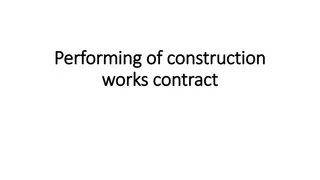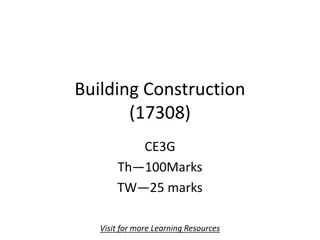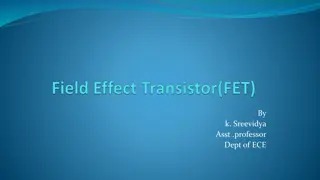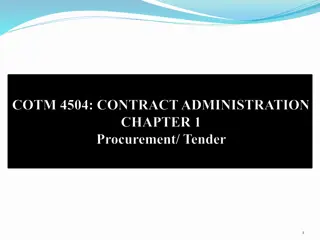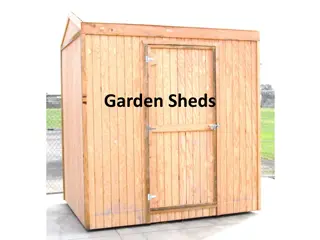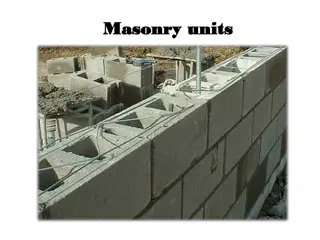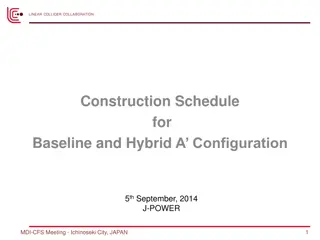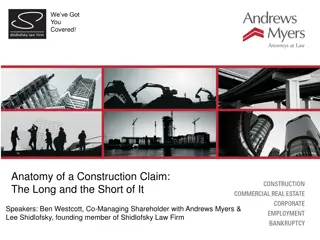Understanding Dozer Performance Characteristics in Construction
A dozer is a significant tractor unit with a blade used for pushing materials in construction projects. It is classified based on running gear as crawler or wheel type, each with its distinct advantages. Dozers play essential roles in various functions like dozing dirt, pushing equipment, and more. Understanding their performance characteristics is crucial for efficient operation and project success.
Download Presentation

Please find below an Image/Link to download the presentation.
The content on the website is provided AS IS for your information and personal use only. It may not be sold, licensed, or shared on other websites without obtaining consent from the author. Download presentation by click this link. If you encounter any issues during the download, it is possible that the publisher has removed the file from their server.
E N D
Presentation Transcript
Lecture 5 Dozer TSP-308 MPK Ferdinand Fassa
OUTLINE Introduction Dozer Performance Characteristics Classified on the basis of running gear Blade Dozer Function Dozer Production Estimating Dozer Safety 1. 2. 3. 4. 2
Introduction A dozer is Tractor unit that has blade attached to push material from one location to another. It is designed to provide for drawbar work. The amount of material the dozer moves is dependent on the quantity that will remain in front of the blade during the push. 3
Introduction (2) Machine used to push or pull objects / material by means of mounted attachment or drawbar Function To doze dirt To push or pull (add traction - drawbar) moving equipment To pull ripper 4
Dozer Performance Characteristics (2) Dimension & Dozing Position TILTING PITCHING 16 ANGLING
Dozer Performance Characteristics Classified on the basis of running gear: Crawler type Wheel type Crawler Dozer Wheel Dozer Work on variety of soil Good on firm soils and concrete Work over almost terrain Best for level and downhill work wet weather Good for short work distances Good for long travel distances Can handle tight soil Best in handling loose soils Slow return speeds, 5-10 mph Fast Return speeds, 8 -26 mph Can push large blade loads Can handle only moderate blade loads 17
Dozer Performance Characteristics (3) Dozer Function Stripping Backfilling Spreading 18
Dozer Production Estimating Dozing Productivity Blade volume, Vb = 0.8HWL Production, Pb = (Vb)/(Tp + Tr + Tm) H W L Tp Tr Tm = height of pile of dirt at the inside edge of each track = width of pile at the inside edge of each track = length of dirt pile width of blade = time to push (doze) = time to return (usually backward in reverse) = time to maneuver L 19 H1 H2 W1 W2
Estimating Dozer Production Total Cycle Time = Fixed Cycle Time + Variable Cycle Time Dozer Production = (Blade Capacity * Efficiency)/ Total Cycle Time 21
Estimating Dozer Production Fixed Cycle Time: Maneuver, Gear Change, Loading & Dumping. Typical Dozer Fixed Cycle Times Operating Conditions Power-Shift Transmission Direct-Drive Transmission Hard Digging Time (min) 0.05 0.10 0.15 22
Estimating Dozer Production Variable Cycle Time: Doze & Return. Typical Dozer Operating Speeds Operating Conditions Hard Materials, Haul < or = 100 ft Hard Materials, Haul > 100 ft Loose Material, Haul < or = 100 ft Loose Material, Haul > 100 ft Speeds (mph) 1.5 2.0 2.0 2.5 23
Dozer Production = + + Cycle Time pushtime returntime maneuverti me blade load x 60 min Production = cycle time O & perhour x O operator perhour = U nitCost production on job efficiency 24
Dozer Production Example A power-shift crawler tractor has a rated blade capacity of 10 LCY. The dozer is excavating loose common earth and pushing it a distance of 200 ft. Maximum reverse speed in third range is 5 mph. Estimate the production of the dozer if job efficiency is 50 min/h. 25
Dozer Production Example Fixed Time = 0.05 min (Table slide 22) Dozing Speed = 2.5 mph (Table slide 23) 200 ft = = Dozing Time 60 min/ 0.91 min x hr 2.5 mph 5280 fpm 200 ft = = Return Time 60 / 0.45 min x mim hr 5.0 mph 280 5 fpm = + + = Cycle Time 0.05 0.91 0.45 1.41 min 26 lcy x 10 50 min hr = = Production 354.6 LCY hr 1.41 min
The machine in example above has an Owning & Operating cost of $ 40.5 per hour. Operator in the area where the proposed work will be performed are paid a wage of $ 15.5 per hour. What is the unit cost for pushing the material? 15.5 + 40.5 = = nitCost U . 0 $ 157 perlcy 354.6 27
Job Management ~ Techniques Downhill Dozing Minimal grade resistance Blade load is increased Reduces cycle times Slot Dozing Shallow trench or path cut between loading and dumping areas to increase the blade capacity that can be carried on each cycle. As much as 50% increase in capacity. Blade-to-Blade Dozing Combined capacity is greater than each separately. Can be mechanically coupled for large jobs. 28
Slot Dozing 29
Practice Dozing performed at a slow speed 2 mph. Return speed Is 4 mph whit maneuve time is about 0.05 min. The dozer is excavating loose common earth and pushing it a distance of 95 ft. A track dozer can push an average blade load 7 lcy. Owning & Operating cost of $ 50 per hour. Operator in the area where the proposed work will be performed are paid a wage of $ 12 per hour. Q..? 1. What production in loose cubic yard can be expected? 2. Assume a percent swell of 0.25 and a job efficiency equal to 45 min per hour. What is the actual production that can be expected in bank cubic yard..? 3. What is the unit cost for pushing this material? 31
= + + Cycle Time pushtime returntime maneuverti me blade load x 60 min Production = cycle time O & perhour x O operator perhour = U nitCost production on job efficiency 32
Practice Answer 95 ft = = Dozing Time 60 min/ . 0 54 min x hr mph 2. 5280 fpm 95 ft = = Return Time 60 min/ . 0 27 min x hr mph 4 5280 fpm lcy x 7 60 min hr = = Production 488.37 LCY hr 0.86 min 33
Practice (2) Answer 488.37 45 = = Production BCY 93 2 hr x 1.25 60 12 + 50 = = nitCost U . 0 $ 212 perbcy 293 34
Thank You 35





